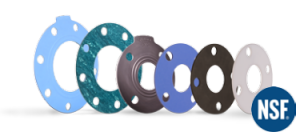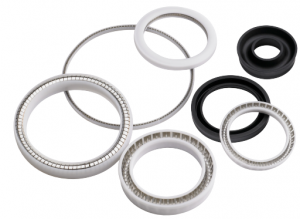Replacing Aging Water Infrastructure With NSF Compliant Materials
There are over 155,000 public water systems in the United States and more than 286 million Americans who rely on community water systems daily. Since most of the infrastructure was built between the early 1900's and 1960 using outdated technology/products and capabilities, nearly everything is approaching the natural end of it's lifespan.
Some estimates put the repairs and replacement of the 
- Joining and sealing materials
- Mechanical devices
- Pipes or related products
- Process media
- Plumbing devices
- Non-metallic potable water materials
- Hydrants
- and Public drinking water distribution (tanks and reservoirs, maters, individual components)
Joining and Sealing Materials
When these systems were being constructed and assembled decades ago, there were limited regulations and requirements that needed to be met. Gaskets, at least the traditional ones, were often made in two different ways: (1) Red Rubber (ASTM D1330 Grade 1 &2) with compressed non-asbestos or (2) cloth-inserted rubber with compressed asbestos.
However, today's acceptable gasket requirements for the potable water industry differ greatly from those in the past. Gaskets have strict guidelines to abide by and must be:
- Chemically resistant
- NSF compliant
- Food grade compliant
- Electrically isolating
Because of the need for health and safety, the National Sanitation Foundation (NSF) was created in order to establish minimum requirements for the control of potential adverse human health effects from products that contact drinking water. In addition to gaskets, the NSF covers a variety of products and parts relevant to the water industry, including: pipes, hoses, fittings, cements, coatings, gaskets, adhesives, lubricants, media, water meters, valves, filters, faucets, fountains, and more.
So you might ask - why does the NSF require different materials and regulations for gaskets compared to years ago?
First things first - leaks are a major issue with the aging infrastructure. Improperly placed gaskets & seals or faulty products can cause leaks. This in turn could pose health risks to people drinking potable water or using products processed with potable water.
Additionally, the treatment process and chemicals utilized are 
Lastly, engineered sealing solutions are more important than ever. There's a wide variety of custom engineered water systems throughout the U.S. - climate, geographic terrain, and the needs of the community are all reasons for why water infrastructure is so unique. Because of this, custom gaskets, seals, and other products are needed to supplement those systems.
Luckily there are many companies dedicated to providing the highest quality NSF 61 products. These trusted brands have proven materials to count-on when replacing or repairing water infrastructure:
Garlock's NSF 61 Family of products
Parker's NSF compliant products
Freudenberg's new generation of NSF products
For more information on how Gallagher Fluid Seals's engineers can help you with a custom solution, call us at 800.822.4063
